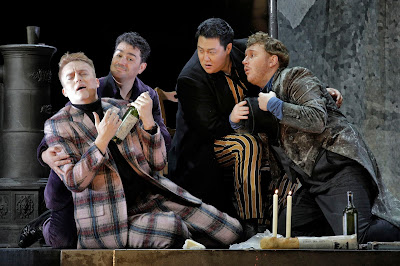https://www.heraldsun.com.au/entertainment/arts/ghost-sonata-is-rarely-seen-and-dense-in-this-production/news-story/abe2407fbf5557fa86e5b6505d148fc2
Published in Herald Sun Melbourne online 26th September, 2019
Based on August Strindberg’s 1907 play and set to music by Aribert Reimann, Ghost Sonata is the type of work that extends the perimeters of what opera might be expected to be. Reimann’s 1984 chamber opera is a challenging 90-minute soundscape to reside in but it has a highly intellectualised approach in Opera Australia’s new production.
Within its festering mood is a story that spotlights the secrets and lies one harbours, to the extreme of creating a persona perceived as someone untrue to self. And what might be better, to hide behind lies for as long as we can or accept our lies and wither away? There doesn’t seem a way out.
It’s uncertain who is alive or dead in this psychological matrix as the characters fatefully come together for ‘The Ghost Supper’ where all is revealed. When they do, the fractured nature of the plot and its distinctive piercing shards of music seem to coalesce and offer a way forward.
A large angled mirror above the stage reflects the action in a way that creates two realities and is lowered after truths are revealed in Emma Kingsbury’s clever design. Ample opportunity is given to ponder over the work’s surrealism as part of Greg Eldridge’s haunting direction and manic blend of seemingly random vocal lines.
There’s The Student who wants to know what is wanted of him, sung with an excellently sharpened and tensile tenor by Shanul Sharma. Powerful bass Richard Anderson is persuasive in rendering the brusque and scheming nature of The Old Man and John Longmuir slingshots an impressive wiry tenor as The Colonel who’s not the noble he pretends to be.
Mezzo Dominica Matthews is a spectral charmer as The Mummy, a squawking pitiful figure who thinks she’s a parrot, and Danita Weatherstone is radiant as The Young Woman. Other roles are firmly delivered while Warwick Stengårds shapes precision and impetus in the score.
In a work bereft of melody, you might be waiting for the penny to drop. Perhaps it won’t but in giving something of oneself, its secrets just might be revealed.
Ghost Sonata
Opera Australia
The Coopers Malthouse, Merlyn Theatre
Until September 29
3.5 stars
Production Photos: Georges Antoni
Published in Herald Sun Melbourne online 26th September, 2019
Based on August Strindberg’s 1907 play and set to music by Aribert Reimann, Ghost Sonata is the type of work that extends the perimeters of what opera might be expected to be. Reimann’s 1984 chamber opera is a challenging 90-minute soundscape to reside in but it has a highly intellectualised approach in Opera Australia’s new production.
 |
| Shanul Sharma as The Student, Danita Weatherstone as The Young Woman and Virgillio Marino as Johansson |
Within its festering mood is a story that spotlights the secrets and lies one harbours, to the extreme of creating a persona perceived as someone untrue to self. And what might be better, to hide behind lies for as long as we can or accept our lies and wither away? There doesn’t seem a way out.
It’s uncertain who is alive or dead in this psychological matrix as the characters fatefully come together for ‘The Ghost Supper’ where all is revealed. When they do, the fractured nature of the plot and its distinctive piercing shards of music seem to coalesce and offer a way forward.
A large angled mirror above the stage reflects the action in a way that creates two realities and is lowered after truths are revealed in Emma Kingsbury’s clever design. Ample opportunity is given to ponder over the work’s surrealism as part of Greg Eldridge’s haunting direction and manic blend of seemingly random vocal lines.
 |
| Richard Anderson as The Old Man, Dominica Matthews as The Mummy and John Longmuir as The Colonel |
There’s The Student who wants to know what is wanted of him, sung with an excellently sharpened and tensile tenor by Shanul Sharma. Powerful bass Richard Anderson is persuasive in rendering the brusque and scheming nature of The Old Man and John Longmuir slingshots an impressive wiry tenor as The Colonel who’s not the noble he pretends to be.
Mezzo Dominica Matthews is a spectral charmer as The Mummy, a squawking pitiful figure who thinks she’s a parrot, and Danita Weatherstone is radiant as The Young Woman. Other roles are firmly delivered while Warwick Stengårds shapes precision and impetus in the score.
In a work bereft of melody, you might be waiting for the penny to drop. Perhaps it won’t but in giving something of oneself, its secrets just might be revealed.
Ghost Sonata
Opera Australia
The Coopers Malthouse, Merlyn Theatre
Until September 29
3.5 stars
Production Photos: Georges Antoni





